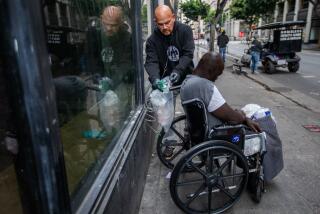A Touch Can Speak Volumes
- Share via
One morning, years ago, I witnessed a handshake I’ll never forget--and learned what hands are really for.
I was an intern working the night shift in the intensive care unit of St. Boniface Hospital in Winnipeg, Canada. The evening began uneventfully. Several patients, all of them stable, didn’t command a lot of attention from us that night. The atmosphere was quiet and settled, with a steady hum of monitors and other high-tech gear providing the background noise.
Then came “Mr. Smith,” a slim, white-haired man in his early 70s who had suffered a heart attack. At first, he had been admitted to the coronary care unit, where less severely ill patients are generally taken, because his condition was stable. Doctors hoped to treat him conservatively, with no surgical or invasive procedures.
But the damage to his heart was greater than first thought, and he was wheeled into intensive care.
The quiet ended, and a buzz of activity began around Mr. Smith. As his already low blood pressure dropped further, nurses hurriedly inserted more IV lines into his arms. Infusion pumps poured fluids and potent medicines into his veins in an attempt to slow the free fall. After a brief and direct discussion about his condition, he was placed on a ventilator to protect his lungs from being flooded with fluid backing up from his ailing heart. Mr. Smith was now unable to talk. Despite the plastic tube invading his throat and the multiple IV lines tethering his arms, he could nod and acknowledge how he was doing.
As his family anxiously waited just outside, the medical resident and I watched Mr. Smith closely throughout the night. We readjusted ventilator settings constantly to maximize his breathing and air exchange. Blood drawn hourly documented abnormal body chemistry that worsened to a critical level. Monitors metered his vital signs. Every few minutes, his heartbeats stuttered with sinister rhythms, setting off alarms.
Throughout it all, Mr. Smith was calm and settled, seemingly oblivious to the blares and hisses of the ventilator, the blood draws and other interruptions. “How are you doing?” I’d ask often. Almost imperceptibly, he would nod that he was doing OK. Fleeting glances and silent stares among staff expressed what we all knew to be true, but was left unspoken. Mr. Smith was not in pain and survived until our morning rounds.
The night was very long, but as the hours passed, outside the window the sky began to gradually lighten.
We reported what had transpired and I reviewed Mr. Smith’s downward course with Dr. Bruce Light, who was in charge of the intensive care unit and was just coming on duty. The conclusion was clear: The battle was over. It fell to Dr. Light to share the inevitable prognosis with Mr. Smith. Most patients in Mr. Smith’s condition are unconscious from their illness or from medications given to relieve suffering. Mr. Smith was alert and coping the best he could. We all gathered by his bedside.
Dr. Light moved next to Mr. Smith on the right side of the bed. “Mr. Smith, you’ve suffered a very bad heart attack, and your heart has been severely damaged.” Mr. Smith opened his eyes. “Throughout the night we’ve tried all the medicines that could possibly help, but there’s been too much injury to the heart. There isn’t anything else we can do.” Then he paused. A moment or two passed with their eyes still locked on each other. “Do you understand what I’m saying?” Mr. Smith nodded.
Another moment or two passed.
Very slowly Mr. Smith raised his right arm and with it all the accompanying plastic tubing. He offered his hand to Dr. Light who embraced it with his own. They both held on for seconds that were minutes long, and then let go. Dr. Light turned away with tears. The sanctity of the moment permeated the core of everyone by the bedside. I stood in profound reverence in the silence that remained.
Some time later the IV lines were pumped with a final barrage of medicines to buy as much time as possible. The ventilator tube was removed so Mr. Smith could speak with his family. The IV lines were stopped and monitors shut off. Mr. Smith had a few minutes before he gradually weakened to the point of unconsciousness and died.
Mr. Smith reaching up and offering his hand to Dr. Light in the face of his impending death taught me what hands are really for. Hands are part of how we communicate, connect and care for one another. They teach us that life is really just about holding on--and letting go.
Mr. Smith knew how to let go. The rest of us just stood there--holding on.
*
J.W. Carter practices life and emergency medicine in Duluth, Minn. He may be reached by e-mail at jcarter@d.umn.edu.
More to Read
Sign up for Essential California
The most important California stories and recommendations in your inbox every morning.
You may occasionally receive promotional content from the Los Angeles Times.













